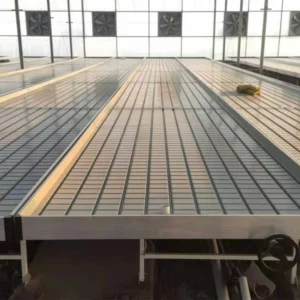Ebb and flow tables, also known as flood and drain tables or flood tables, are hydroponic systems commonly used in indoor gardening and plant propagation. The primary function of ebb and flow tables is to provide a controlled environment for plants to grow by periodically flooding the growing medium with nutrient-rich water and then draining it away.
Here’s how they work:
- Nutrient Delivery: Ebb and flow tables function as reservoirs for nutrient solutions. The table is filled with a nutrient solution, which is then circulated to the plants’ root systems. The nutrient solution provides essential elements for plant growth, such as water, minerals, and nutrients.
- Flood Cycle: During the flood cycle, the table is filled with the nutrient solution, which submerges the plant’s root zone. The flooding duration can vary depending on the specific requirements of the plants being grown. The nutrient solution is typically maintained at a certain depth for a specific period, allowing the plants to absorb water and nutrients.
- Drainage Cycle: After the flood cycle, the nutrient solution is drained from the table, allowing excess water to be removed from the growing medium and preventing waterlogging. The drainage cycle provides oxygen to the roots and prevents the roots from sitting in stagnant water for extended periods.
- Oxygenation: Ebb and flow tables promote oxygenation of the root zone. During the drainage cycle, air is drawn back into the root zone, providing oxygen to the plants’ roots. This oxygenation is crucial for healthy root development and prevents root rot, which can occur in stagnant or oxygen-deprived conditions.
- Nutrient Uptake: The periodic flooding and draining cycles of ebb and flow tables help promote efficient nutrient uptake by the plants. The flood cycle ensures that the roots have access to a nutrient-rich solution, while the drainage cycle allows the roots to take in oxygen and prevents nutrient buildup or imbalances.
- Water Conservation: Ebb and flow tables are designed to minimize water usage by recycling and reusing the nutrient solution. As the solution is drained from the table, it can be collected and returned to the nutrient reservoir for the next flood cycle. This promotes water conservation in hydroponic systems.
Ebb and flow tables provide a controlled and efficient method of delivering water and nutrients to plants while maintaining proper aeration and preventing water stagnation. They are commonly used in hydroponic systems for a range of plants, including vegetables, herbs, and flowers.
How do ebb and flow tables compare to other hydroponic systems in terms of plant growth and yield?
Ebb and flow tables, as a hydroponic system, offer several advantages and considerations compared to other hydroponic systems in terms of plant growth and yield.
Here’s a comparison:
Advantages of Ebb and Flow Tables:
- Versatility: Ebb and flow tables are suitable for a wide range of plants, including vegetables, herbs, and flowers. They can accommodate plants of various sizes and growth stages, making them versatile for different crops.
- Nutrient Delivery: Ebb and flow tables allow for precise control over nutrient delivery. The flood and drain cycles ensure that plants have access to water and nutrients while preventing waterlogging and nutrient imbalances.
- Oxygenation: The intermittent flooding and draining cycles of ebb and flow tables promote oxygenation of the root zone. This oxygen availability helps stimulate root growth, nutrient absorption, and overall plant health.
- Water Conservation: Ebb and flow tables are relatively water-efficient compared to some other hydroponic systems. The ability to recirculate and reuse the nutrient solution minimizes water usage and reduces the overall water consumption of the system.
Considerations of Ebb and Flow Tables:
- Maintenance: Ebb and flow tables require regular maintenance to ensure proper functioning. This includes monitoring and adjusting nutrient levels, checking for clogs or blockages in the drainage system, and maintaining proper pump operation.
- Risk of System Failure: If the ebb and flow system experiences a malfunction or power outage during the flood cycle, there is a risk of waterlogging or root suffocation. It is crucial to have backup power or fail-safe mechanisms in place to prevent such incidents.
- Uniformity: Achieving uniform and consistent flooding and draining cycles across the entire table can be challenging. Uneven water distribution or drainage can lead to uneven plant growth and nutrient uptake.
Comparing Yield Potential:
The yield potential of ebb and flow tables can be comparable to other hydroponic systems, but it depends on various factors such as crop selection, system design, environmental conditions, and grower expertise. With proper management and optimization, ebb and flow tables can support robust plant growth and high yields.
It’s worth noting that different hydroponic systems, such as nutrient film technique (NFT), deep water culture (DWC), or aeroponics, may offer specific advantages in terms of water efficiency, nutrient delivery, or growth rates, depending on the crop and specific requirements. The choice of hydroponic system should be based on the specific needs, goals, and resources of the grower.
